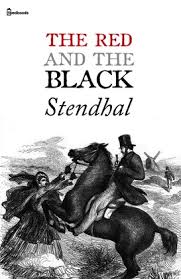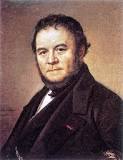The Red and the Black
Le Rouge et le Noir is a historical psychological novel in two volumes by Stendhal, published in 1830. It chronicles the attempts of a provincial young man to rise socially beyond his modest upbringing through a combination of talent, hard work, deception, and hypocrisy.
INTRODUCTION Some slight sketch of the life and character of Stendhal is particularly necessary to an understanding of Le Rouge et Le Noir (The Red and the Black) not so much as being the formal stuffing of which introductions are made, but because the book as a book stands in the most intimate relation to the author's life and character. The hero, Julien, is no doubt, viewed superficially, a cad, a scoundrel, an assassin, albeit a person who will alternate the moist eye of the sentimentalist with the ferocious grin of the beast of prey. But Stendhal so far from putting forward any excuses makes a specific point of wallowing defiantly in his own alleged wickedness. "Even assuming that Julien is a villain and that it is my portrait," he wrote shortly after the publication of the book, "why quarrel with me. In the time of the Emperor, Julien would have passed for a very honest man. I lived in the time of the Emperor. So--but what does it matter?" Henri Beyle was born in 1783 in Grenoble in Dauphiny, the son of a royalist lawyer, situated on the borderland between the gentry and that bourgeoisie which our author was subsequently to chastise with that malice peculiar to those who spring themselves from the class which they despise. The boy's character was a compound of sensibility and hard rebelliousness, virility and introspection. Orphaned of his mother at the age of seven, hated by his father and unpopular with his schoolmates, he spent the orthodox unhappy childhood of the artistic temperament. Winning a scholarship at the Ecole Polytechnique at the age of sixteen he proceeded to Paris, where with characteristic independence he refused to attend the college classes and set himself to study privately in his solitary rooms. In 1800 the influence of his relative M. Daru procured him a commission in the French Army, and the Marengo campaign gave him an opportunity of practising that Napoleonic worship to which throughout his life he remained consistently faithful, for the operation of the philosophical materialism of the French sceptics on an essentially logical and mathematical mind soon swept away all competing claimants for his religious adoration. Almost from his childhood, moreover, he had abominated the Jesuits, and "Papism is the source of all crimes," was throughout his life one of his favourite maxims. After the army's triumphant entry into Milan, Beyle returned to Grenoble on furlough, whence he dashed off to Paris in pursuit of a young woman to whom he was paying some attention, resigned his commission in the army and set himself to study "with the view of becoming a great man." It is in this period that we find the most marked development in Beyle's enthusiasm of psychology. This tendency sprang primarily no doubt from his own introspection. For throughout his life Beyle enjoyed the indisputable and at times dubious luxury of a double consciousness. He invariably carried inside his brain a psychological mirror which reflected every phrase of his emotion with scientific accuracy. And simultaneously, the critical spirit, half-genie, half-demon inside his brain, would survey in the semi-detached mood of a keenly interested spectator, the actual emotion itself, applaud or condemn it as the case might be, and ticket the verdict with ample commentations in the psychological register of its own analysis. But this trend to psychology, while as we have seen, to some extent, the natural development of mere self-analysis was also tinged with the spirit of self-preservation. With a mind, which in spite of its natural physical courage was morbidly susceptible to ridicule and was only too frequently the dupe of the fear of being duped, Stendhal would scent an enemy in every friend, and as a mere matter of self-protection set himself to penetrate the secret of every character with which he came into contact. One is also justified in taking into account an honest intellectual enthusiasm which found its vent in deciphering the rarer and more precious manuscripts of the "human document." With the exception of a stay in Marseilles, with his first mistress Mélanie Guilhert ("a charming actress who had the most refined sentiments and to whom I never gave a sou,") and a subsequent sojourn in Grenoble, Stendhal remained in Paris till 1806, living so far as was permitted by the modest allowance of his niggard father the full life of the literary temperament. The essence, however, of his character was that he was at the same time a man of imagination and a man of action. We consequently find him serving in the Napoleonic campaigns of 1806, 1809 and 1812. He was present at the Battle of Jena, came several times into personal contact with Napoleon, discharged with singular efficiency the administration of the State of Brunswick, and retained his sangfroid and his bravery during the whole of the panic-stricken retreat of the Moscow campaign. It is, moreover, to this period that we date Stendhal's liaison with Mme. Daru the wife of his aged relative, M. Daru. This particular intrigue has, moreover, a certain psychological importance in that Mme. Daru constituted the model on whom Mathilde de la Mole was drawn in The Red and the Black. The student and historian consequently who is anxious to check how far the novelist is drawing on his experience and how far on his imagination can compare with profit the description of the Mathilde episode in The Red and the Black with those sections in Stendhal's Journal entitled the Life and Sentiments of Silencious Harry, Memoirs of my Life during my Amour with Countess Palfy, and also with the posthumous fragment, Le Consultation de Banti, a piece of methodical deliberation on the pressing question. "Dois-je ou ne dois-je pas avoir la duchesse?" written with all the documentary coldness of a Government report. It is characteristic that both Bansi and Julien decide in the affirmative as a matter of abstract principle. For they both feel that they must necessarily reproach themselves in after life if they miss so signal an opportunity. Disgusted by the Restoration, Stendhal migrated in 1814 to Milan, his favourite town in Europe, whose rich and varied life he savoured to the full from the celebrated ices in the entreates of the opera, to the reciprocated interest of Mme. Angelina Pietragrua (the Duchesse de Sansererina of the Chartreuse of Parma), "a sublime wanton à la Lucrezia Borgia" who would appear to have deceived him systematically. It was in Milan that Stendhal first began to write for publication, producing in 1814 The Lives of Haydn and Mozart, and in 1817 a series of travel sketches, Rome, Naples, Florence, which was published in London. It was in Milan also than Stendhal first nursed the abstract thrills of his grand passion for Métilde Countess Dunbowska, whose angelic sweetness would seem to have served at any rate to some extent as a prototype to the character of Mme. de Rênal. In 1821 the novelist was expelled from Milan on the apparently unfounded accusation of being a French spy. It is typical of that mixture of brutal sensuality and rarefied sentimentalism which is one of the most fascinating features of Stendhal's character, that even though he had never loved more than the lady's heart, he should have remained for three years faithful to this mistress of his ideal.
Translation
Translate and read this book in other languages:
Select another language:
- - Select -
- 简体中文 (Chinese - Simplified)
- 繁體中文 (Chinese - Traditional)
- Español (Spanish)
- Esperanto (Esperanto)
- 日本語 (Japanese)
- Português (Portuguese)
- Deutsch (German)
- العربية (Arabic)
- Français (French)
- Русский (Russian)
- ಕನ್ನಡ (Kannada)
- 한국어 (Korean)
- עברית (Hebrew)
- Gaeilge (Irish)
- Українська (Ukrainian)
- اردو (Urdu)
- Magyar (Hungarian)
- मानक हिन्दी (Hindi)
- Indonesia (Indonesian)
- Italiano (Italian)
- தமிழ் (Tamil)
- Türkçe (Turkish)
- తెలుగు (Telugu)
- ภาษาไทย (Thai)
- Tiếng Việt (Vietnamese)
- Čeština (Czech)
- Polski (Polish)
- Bahasa Indonesia (Indonesian)
- Românește (Romanian)
- Nederlands (Dutch)
- Ελληνικά (Greek)
- Latinum (Latin)
- Svenska (Swedish)
- Dansk (Danish)
- Suomi (Finnish)
- فارسی (Persian)
- ייִדיש (Yiddish)
- հայերեն (Armenian)
- Norsk (Norwegian)
- English (English)
Citation
Use the citation below to add this book to your bibliography:
Style:MLAChicagoAPA
"The Red and the Black Books." Literature.com. STANDS4 LLC, 2025. Web. 22 Feb. 2025. <https://www.literature.com/book/the_red_and_the_black_201>.








Discuss this The Red and the Black book with the community:
Report Comment
We're doing our best to make sure our content is useful, accurate and safe.
If by any chance you spot an inappropriate comment while navigating through our website please use this form to let us know, and we'll take care of it shortly.
Attachment
You need to be logged in to favorite.
Log In